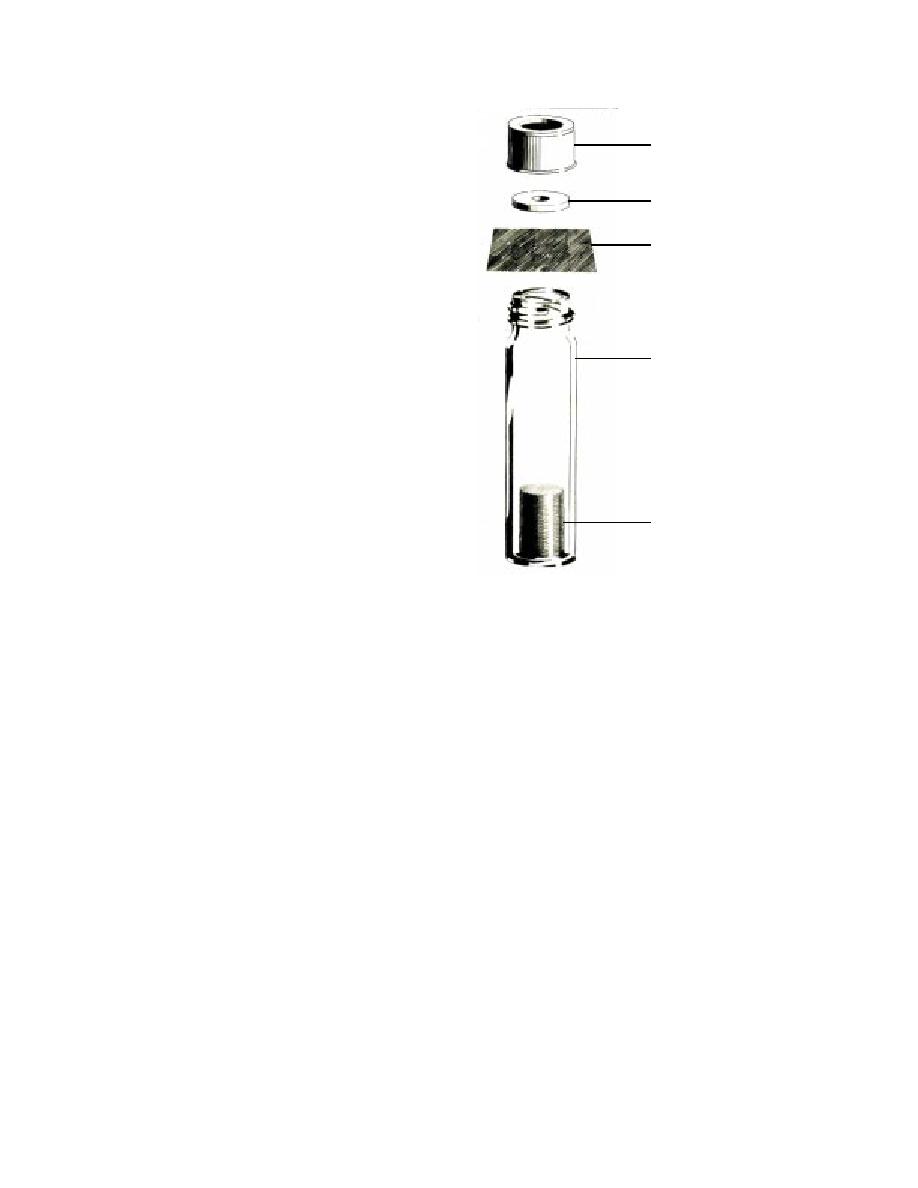
tions should be site-specific and they must be an-
alyzed under the same conditions as the samples.
Screw Cap
For practical reasons, instrument response for the
0.2-mg/kg working standard concentration
should be at least 10 greater than the back-
Teflonlined septum
with access hole
ground response. Other important criteria are
that the technique should be rapid, should
Aluminum foil
require only a small amount of soil, should be
easily implemented on site, and should be robust.
In this study, we used a total-VOC analyzer to
perform this task. Information concerning the
theory of soil vapor analysis with these instru-
ments can be found elsewhere (Fitzgerald 1989,
Robbins et al. 1990). The on-site analysis proce-
40 mL vial
dure developed here uses a hand-held total-VOC
analyzer, takes less than 5 seconds for an analysis,
and requires only 10 or 20 g of contaminated soil
for most chlorinated and gasoline range organic
compounds. Collection and preparation of a soil
sample takes less than 1 minute. Proper prepara-
tion and analysis of working standards calibrate
sample results to both the sample matrix and the
existing meteorological conditions, and, depend-
Standard or soil sample
ing on the objectives, will allow us to estimate a
range of concentrations or test whether concen-
trations are above or below 0.2 mg VOC/kg. With
Figure 1. Modified VOA vials for rapid total VOC
the exception of a single commercial or laboratory-
soil vapor analysis.
prepared stock standard, this procedure only
requires instrumentation and materials already
with a 10-mL disposable plastic syringe, with the
common to most site investigations, i.e., VOA vials,
tip, rubber plunger cap, and holding post
syringes, and a portable total-VOC analyzer.
removed (Hewitt et al. 1995). Reagent grade
trichloroethene (TCE), fresh unleaded gasoline,
MATERIALS AND METHODS
and purge and trap grade MeOH were used to
prepare the stock standards. We used a 10-L sy-
Equipment and materials
ringe (Hamilton) to transfer volumes of the stock
The total-VOC analyzers used in this study
standard when preparing the working standards.
were both equipped with Photo Ionization Detec-
tors (PIDs): the Microtip HL-2000 (Photovac, Inc.)
Soil vapor analysis
and the Model 580B OVM (Thermo Environmen-
In preparation for a soil vapor analysis, the
tal Instruments, Inc.). The Microtip HL-2000 was
PID instruments were initially calibrated using
modified by replacing the sampling line with a 3-
zero grade air and standard gas (100 ppm isopro-
cm-long Teflon tube (3.17 mm o.d.) having a
pylene) cylinders. To carry out an analysis, soil in
pointed tip. Clear, 44-mL VOA vials were selected
5-g increments (approximate amount transferred
as vessels for the working standards and for the
when a 10-mL syringe is filled with 3 mL of soil)
analysis of on-site soil vapor samples. We modi-
was transferred to the VOA vial after the cap, sep-
fied the vials by punching a 5-mm-hole in the
tum, and foil liner were removed. Special care
center of the Teflon-lined silicone septum to al-
was taken when collecting and transferring the
low air to easily pass around the PID sampling
soil subsample to minimize disaggregation. Fill-
line once it was inserted through the hole. To tem-
porarily cover the vials, 3- 3-cm squares of a
ing the syringe with more than 3 mL of soil is not
recommended because larger amounts are often
light gauge aluminum foil were pressed over the
difficult to remove, and are easily disaggregated.
entire rim of the glass vial, then covered with the
Once the appropriate volume of soil was ob-
hole-punched septum and screw cap (Fig. 1). Soil
tained and the foil liner, septum, and cap tightly
was collected and transferred to these vessels
3



 Previous Page
Previous Page
